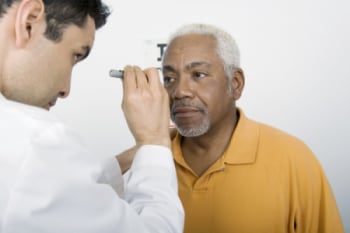Telemedicine Increases Diabetic Eye Exams
Oregon Health and Science University, Prevention Research Center

Overview
Oregon Health and Science University Prevention Research Center (PRC) is researching the effectiveness of using telemedicine to prevent blindness from diabetic retinopathy.
The leading cause of blindness in working-age adults is eye disease related to poorly managed diabetes.1 Diabetic retinopathy is significant because an 83% increase in diabetes is expected—24 million in 2009 to 44 million by 2034.1
Minority populations including American Indian/Alaska Natives are two times more likely to have diabetes than non-Hispanic whites.1 There is a 78% chance that people with poorly managed diabetes for more than 15 years will develop eye disease.
Early diagnosis through screening and treatment of diabetes-related eye disease are 90% effective in preventing blindness.1 In many communities, it can be challenging to obtain eye exams from eye care providers due to:
94% of telemedicine participants were screened for diabetic eye disease at their community health clinic versus 56% when referred out to an eye care provider.
- Lack of transportation.
- Lack of health insurance.
- Limited access to eye care providers.
- Financial burdens such as co-pays or other associated cost of the exam.
Research Question
Does screening for diabetic eye disease using telemedicine at community health clinics increase the number of people getting eye exams? Telemedicine is the use of electronic information and telecommunications to support and promote long-distance clinical health care, patient and professional health-related education, public health care, and health administration.2
Study
During their visits to community health clinics, over 500 diabetic patient participants were assigned to either a telemedicine screening group or were referred out to a traditional eye care provider. Technicians at the clinic took pictures of both eyes using a specially designed digital camera, and the telemedicine system automatically created and e-mailed an evaluation report to the clinic staff.
The Bottom Line
More of the telemedicine participants got screened for diabetic eye disease at their community health clinic than participants being referred out to an eye care provider—94% were screened via telemedicine versus 56% when referred out.
Learn more: Comparative Effectiveness of Telemedicine to Detect Diabetic [PDF – 285KB]
References
1 Mansberger SL, Gleitsman K, Gardiner S., et al. Comparing the effectiveness of telemedicine and traditional surveillance in providing diabetic retinopathy screening examinations: a randomized controlled trial. Telemedicine Journal and E-Health. 2013;12:942–948.
2 Center for Connected Health Policy. Telemedicine Website. https://www.cchpca.org/about/about-telehealth. Accessed August 28, 2017.